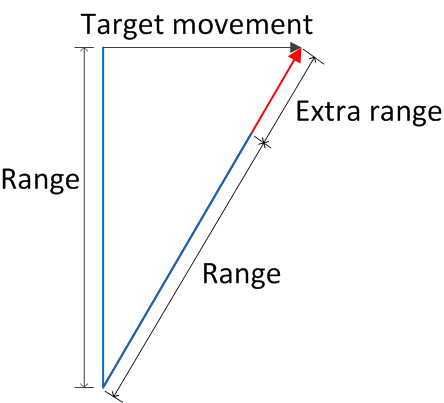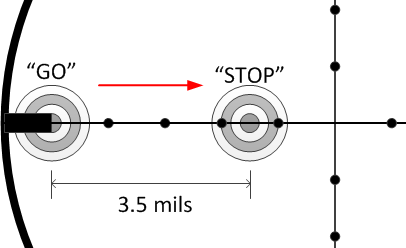Moving target - 1
The objective here is to send a bullet to where the target will be. So in essence, the target places itself in front of an oncoming bullet!
It is like football. The quarter back does not trow the ball at the receiver. He trows it where he hopes the receiver will be by the time the ball gets there.
The data required to calculate the lead is the following:
- Target range.
- Target direction.
- Target speed.
- Bullet speed at the muzzle and at the target's range.
For now, let's assume the wind is null.
1. Target range and 2. Target direction
Target direction can be judged by simple observation. All calculations here will be done for a target moving at a 90° angle. If the target moves at a 45° angle, use 1/2 the calculated value.
For target range, use the mildot, laser range finder, or any other method.
Math or physics inclined readers might object that range will vary as the target moves. And they would be right!
However this theoretical variation is very small in practice. I calculated the differences for targets moving at 3 mph, 6 mph and 10 mph, for ranges from 100 to 1000 yards. See this pdf file for the results.
Even if you let the target move for 1 minute before sending it, the range difference is below 1 yard for almost all distances. For the worst case, 100 yards range with a target moving at 10 mph for 1 minutes, the range variation is 2.95 yards. Three yards out of 100 will not make you miss the target.
So calculate your range as you would normaly do and do not wait to long before sending it.

3. Target speed
Many estimates are used. The most commonly used are:
- Walking: 3 mph.
- Running: 6 mph.
- Quick dash: 10 mph.
I will show you a method for calculating an exact value.
Back to high school physics:

Time can be measured with a simple stop watch or chronometer.
The distance can be evaluated quite simply with a mildot scope. When the target crosses a point of your reticule, call "GO". Your spotter starts his chronometer. When the target has moved a certain number of mils in you scope, call "STOP". The spotter stops his chronometer and notes the time it took.

Since you know the range to the target, you can use this formula to calculate it's speed:

Note: the size of 1 mil at target range is usually known in inches, so divide by 12 to get it in feet.
Example:
- Range: 600 yards.
- Direction: 90°.
- Distance in mils: 5 mils.
- size of 1 mil at 600 yards: 21 inches.
- Time taken: 2 seconds.
![[ 5 mils * ( 21 inches / 12 ) ] / 2 seconds = 4.375 fps](images/moving1-ex1-calculation.png)
4. Bullet speed at the muzzle and at the target's range
The bullet speeds are published by the manufacturer.
The ammunition I use the most is the Federal Gold Match .308 168 grains ammunition. It's velocity at different ranges is:
| Range (yards) | 0 (muzzle) | 100 | 200 | 300 | 400 | 500 | 600 | 700 | 800 | 900 | 1000 |
|---|---|---|---|---|---|---|---|---|---|---|---|
| Velocity (fps) | 2600 | 2420 | 2240 | 2070 | 1910 | 1760 | 1610 | 1480 | 1360 | 1260 | 1170 |
Formulas

